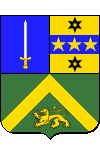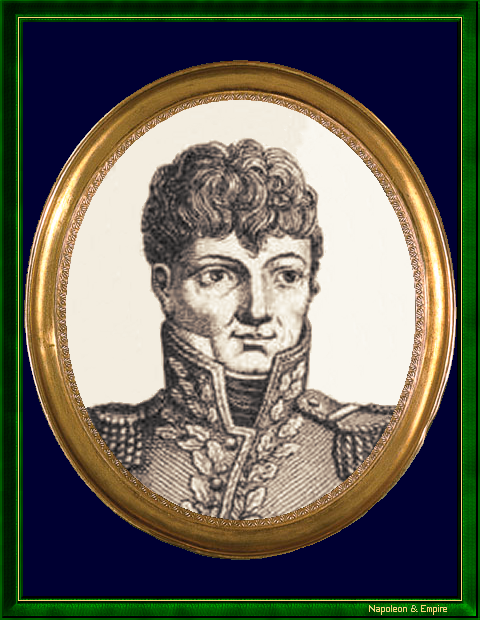Jean-Baptiste Broussier
Count of the Empire
Pronunciation:

Jean-Baptiste Broussier was born on March 10, 1766, in Ville-sur-Saulx, in the province of Lorraine (now in the Meuse department). He was the son of Nicolas François Broussier, a gendarme in the King's household, and Catherine Fortin.
His parents having chosen a career in the Church for him, he pursued his higher education at the seminary in Toul after secondary school at the college in Bar-le-Duc.
In 1791, he enlisted in a battalion of volunteers from the Meurthe region, which elected him captain in September.
The early years of his career were spent on the northern and eastern fronts of France, where he sustained several serious wounds.
The Army of Italy welcomed him in 1797 as a battalion commander. He was quickly promoted to brigade commander (colonel) after distinguishing himself at La Spezia and during the capture of the fort of La Chiusa, near Tarvisio, which he was among the first to enter.
Broussier joined the staff of Guillaume Philibert Duhesme's division in the Army of Rome in 1798, then transferred to the Army of Naples. In January 1799, he seized control of the Duchy of Benevento by annihilating a militia of 12,000 peasants. The commander-in-chief of the Army of Naples, Jean-Étienne Championnet, appointed him brigadier general less than a week later. In this position, he participated in the capture of Naples [Napoli], dispersed Cardinal Fabrizio Dionigi Ruffo's army, subdued Apulia [Puglia], and captured the cities of Trani and Andria.
Shortly afterward, he was dismissed and brought before a court-martial for embezzlement, along with his superiors Championnet and Duhesme. Like them, he escaped punishment and regained his rank following the coup d'état of June 18, 1799 (30 Prairial, Year VII), which restored power to the neo-Jacobins and solidified the generals' influence over the regime.
The following year, General Broussier participated in the second Italian campaign, contributing to the capture of Fort Bard (June 1, 1800) and Cremona (June 13). He remained in Italy until 1803 as governor of Milan [Milano], then Parma, and Piacenza.
Upon returning to France, Broussier became a major general in February 1805 before taking command of the Paris garrison in September.
After leading the staff of the Army of the North and then a division of the Army of Reserve under Marshal François Joseph Lefebvre, he crossed the Alps again in 1806 to command the 2nd Division of the 2nd Corps of the Army of Italy.
In 1809, he commanded the 1st Division of the Army of Italy under Marshal Étienne Macdonald. He fought at Sacile (April 16, 1809), on the Piave River (May 8, 1809), Tarvis (May 18), and captured Ljubljana (May 22) and Graz (June 26). On June 24 and 27, he defeated Marshal Ignaz Giulay's army before playing a significant role in the French victory at the battle of Wagram. On October 15 of the following year, he was made a Count of the Empire.
Until 1812, he held various commands in Italy, including that of Governor of the Brescia military region. He then accompanied Eugène de Beauharnais, Viceroy of Italy, on the French invasion of Russia. His division, the 14th Infantry of the 4th Corps, contributed to the victories at Ostrovno [Астроўна] (July 25 and 26, 1812), Borodino (September 7), and then, at the beginning of the retreat, at Maloyaroslavets [Малоярославец] (October 24). During the Second Battle of Krasnoy [Кра́сный] in November, it sacrificed itself to save the remainder of Eugène's corps. The remnants of the division (400 men out of the 3,000 who had left Smolensk four days earlier), already resigned to death or captivity, were rescued from this grim fate by the arrival of Marshal Louis-Nicolas Davout's troops.
The following year, at the end of the Saxony campaign, Broussier was appointed to command the 3rd Division of the Observation Corps in Mainz, then the fort of Kehl and the city of Strasbourg. He entrenched himself there and defended it until the peace treaty was signed in the spring of 1814.
A Knight of Saint Louis since June 1814, Jean-Baptiste Broussier suffered a fatal stroke on December 13th in Bar-le-Duc, shortly after taking command of the Meuse military division. He was buried in the city.
"Jean-Baptiste Broussier." 19th-century engraving.

The name of Jean-Baptiste Broussier is inscribed on the Arc de Triomphe (north pillar, 7th column).